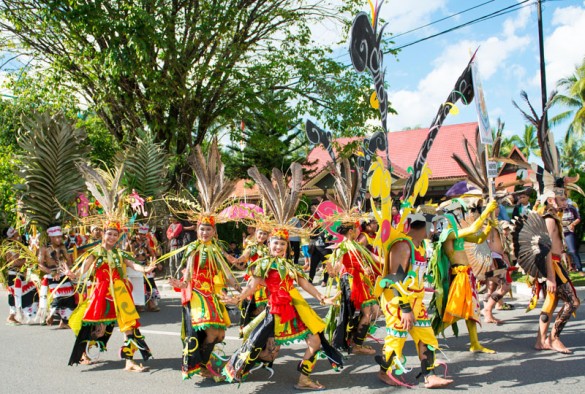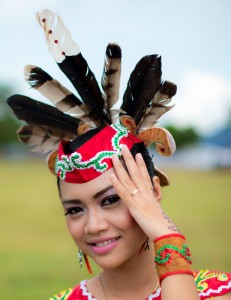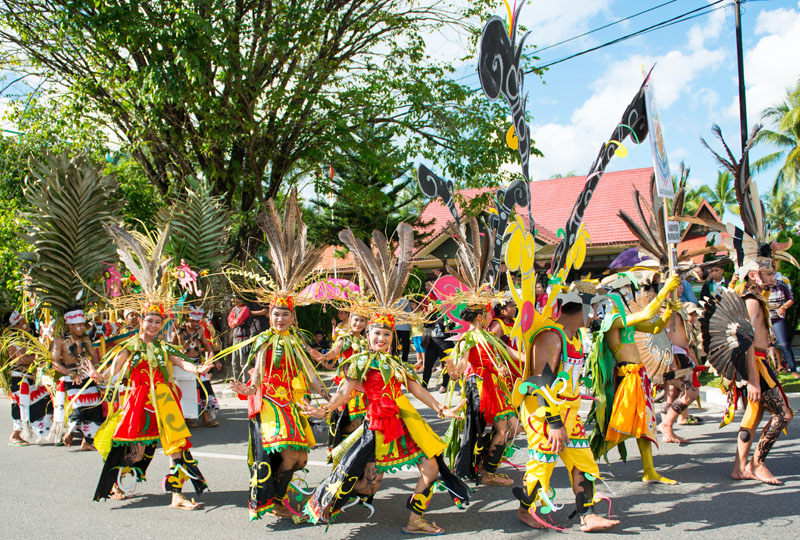

A very special event occurs in Central Borneo on May the 18th each year. Thousands of Dayaks converge on the small city of Palangkaraya to join together in a spirit of dance, fun, joy and cultural expression. They come from the river village settlements, from the forests and inland villages, young and old and somewhat in between, representing their districts and hometowns, determined to compete against the best on offer in dance, song, beauty, sports and traditional games in the third largest province in Indonesia, Central Kalimantan.
Isen Mulang means ‘never give up and strive to achieve’, and this event has been celebrated for the past eight years, which seems to get bigger every year. It is one of the few opportunities in Kalimantan to watch a gathering of so many Dayak tribes together in one place.
This fantastic event begins with a traditional parade, which involves not only Dayak people, but also many other Indonesian cultures that moved to Central Kalimantan under the migrant transmigration program of the Soeharto era. People from Java, Sumatra, Sulawesi, Papua, the Maluku Islands, Bali and Nusa Tenggara are all represented in a colourful parade which winds its way through the streets of Palangkaraya ending up in the centre of town, where many of the participants gather to dance, socialize and pose for cameras.
Palangkaraya, which celebrated its 57th year anniversary this year, means ‘a sacred, glorious and crowded place’, and this is certainly the case as most of the town shows up to watch the parade and join in the festivities.

The highlight of the first day of events is the vibrant and very loud dragon boat contest. Much care and effort is put into decorating the boats in intricate Dayak motifs, which are then paraded up and down the river. Beautiful young Dayak women sing and dance, and young warriors dressed in feathers, their bodies adorned with (temporary) tattoos specially crafted for the occasion, chant ancient songs and swing their parang (machetes) in the air, as they challenge the other boats.
This event is taken very seriously, as there are points awarded for the best decorated boat, best costume, best dance, best singing and the level of enthusiasm displayed. The prize is not only monetary; each team vies for bragging rights as they stand proudly on the bow of the ship, sailing proudly up the river after the winner is announced.
When the boats come in to shore, the contestants turn on yet another display of singing and dancing and then mingle with their friends in the crowd. This is a great opportunity to talk to the very friendly people of Palangkaraya, who are very excited to meet foreigners, as very few tourists visit their town mainly due to ineffective publicity and marketing outside of Kalimantan, rather than lack of things to see.
Day three includes the fascinating but serious game of ‘fireball football’, which sees teams compete on a small sized football field with coconuts that are literally doused in petrol and set alight! I think the crowd gets just as much excitement as the players and when the fireball flies into the crowd due to a wayward kick, this is received with much humour and a mass nervous exit. It is hilarious to watch the large crowd scram in all directions when the ball of fire comes their way.
The players themselves cover their legs in toothpaste, preventing them from getting burnt, although it is not so good for the goalie, who often dives on the coconut to save a goal, risking setting his clothes on fire.
Also on this evening the Prince and Princess of Tourism Competition begins. This event is held over three nights, involving 24 contestants performing in pairs, representing their regencies. There is a lot at stake for this event, as the winners get to represent Central Kalimantan in Jakarta at the National Tourism Competition later in the year.
There are three judges at each event and voting is based on eight categories including dress, appearance, confidence, cultural expression, English speaking ability, dancing, creativity and effectively promoting tourism for their regencies. The contestants are aged between 17 and 23 and are dressed in beautiful, native costumes, making a spectacular sight with flashes of vibrant colour filling the stage as they dance, sing and perform to impress the judges.

The fourth day of the festival includes wood chopping, blow dart shooting, in which the contestants aim at a round target, not another Dayak as they would have in the past! Other festivities include a grand food baking competition, traditional canoe races and fish-catching (with bare hands).
It is in the evening, though, that the magic of the festival really comes alive. The large stage fills with giant feathers, bear claws, pointed hornbill beaks, bells and chains. The Dayaks, representing their many tribes including the Ngaju, Maanyan, Lawangan, Katingan, Barito and Ot Danum, host four hours of traditional dancing. The display of their unique traditional dance costumes and the spirit of the competition create a wonderful atmosphere of entertainment, as each tribe seeks to be crowned ‘the best dancers’ of Central Kalimantan. Some contestants use fire to attract the judge’s attention, which seems to blends in perfect synchronicity with the beautiful flowing hand movements of the female and male dancers.
The following evening, many of the same dancers perform the coastal or Melayu dance, which is slower and quite a different dance performance, yet just as evocative. The final day of this extraordinary festival involves the youth. Thousands of dancers from the age of six to young teens dance in a large field in front of the Governor, which is a great way to end the six days of excitement. Colour, joy, fun and ancient Dayak culture is still very much alive as it has been for thousands of years.
Fast Facts:
Location: Palangkaraya is the capital of the Indonesian province of Central Kalimantan, also known as Central Borneo. The town is situated between the Kahayan and Sabangau rivers.
Population: According to the 2010 census, Central Kalimantan have a population of approximately 220,000 people, with an average population density of 92.1 per km2. The languages spoken are a mixture of Indonesian, English, Banjar and the local Dayak languages, such as the Dayak Ngaju language.
Getting there: Daily flights are available from Jakarta and Surabaya (other cities will require a layover in Jakarta) to Palangkaraya’s Tjilik Riwut airport (formerly Panarung airport), with Lion Air, Sriwijaya Air or Garuda Indonesia.
Things to do: Visit the orangutan conservation centre, witness the Dayak culture through Isen Mulang and other festivals alike, trekking in the rainforest, hiking, jungle river cruises, visit the Balanga museum and many more.
Local Transportation: Plenty of taxi services from the airport, some hotels offer pick-up/drop-off services. There are numerous transport companies or charter car companies throughout the town. Public transportation, such as minibuses or angkot are available.




